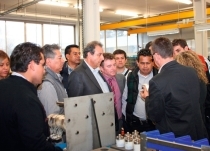Excellent German-Russian Cooperation: The Uvalnaya Project
A new mine site is being developed near Nowokusnezk: Uvalnaya. Here, four coal seams are to be found in a depth of 100 to 400 m, which are 2 to 3.5 m thick and - this is the essential point - contain valuable coking coal. DMT and the RWTH Aachen analyzed the coal and DMT carried out the carbonization trials. The result: this is exactly the raw material that coking plants all over the globe need, namely good coking coal with extraordinary properties.
High Market Potential
Given the currently rising coal prices, this investment has come right on time. Coking coal mines are closing down all over the world, while new investments are hardly arranged. However, this coal has great market potential, in particular when the economic situation of the steel industry will pick up again.
“Never before have I seen such a coal in Russia, nor in the neighborhood of the new mine site”, says Ingo Elsner, Head of the Trading Department of the RAG Group. The special feature of this coal is its low internal gas pressure. Many coking coals from other deposits show excessive internal gas pressure, which can be harmful to coke ovens. By adding coal from this new mine, such annoying properties can be compensated. Elsner explains: “I know a lot of coking plants that need exactly this type of coal to produce the ideal application mixture. Up to 30 % are required for that purpose.”
The DMT certificate acknowledges: “Most properties of the Uvalnaya coal are very favorable for hard coking coal”, and: “The quality of the coke from the first test shows good CRI and CSR values”.
German Mining Knowhow Much in Demand
Besides DMT and the RWTH Aachen, even other German companies are involved in the mine site: GTA, SMT Scharf, Becker Mining, CFT, Aumund Fördertechnik, Hauinco - suppliers with global reputation for high-quality products. The mine will be equipped with sophisticated technology; this ensures a high safety standard and efficiency.
The works in the mine are according to plan, the first coal seam has been reached, the first main ventilator is installed and the work at the open-cast mines is in full swing. The concrete works are expected to be completed in the following year, as temperatures of up to -30° C are no rarity in this region.
The process-engineering part of the coal washing plant was designed by DMT, who look back on more than 100 years of experience in hard coal processing; and German companies, such as Siebtechnik, Allmineral, Schenck, Andritz and others will provide the tried and tested core components. The mine is expected to go into full operation in early 2018.
The Uvalnaya mine represents an outstanding example of cooperation between German and Russian engineers.








